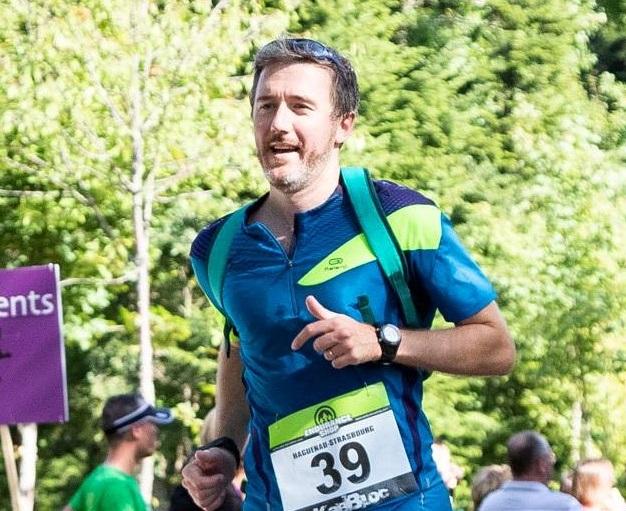MilliporeSigma Employee Spotlight: Fabien Thibault

As part of our brand-new employee spotlight series, we’re sitting down with Fabien Thibault, global manager of product and packaging sustainability at MilliporeSigma — the Life Science business of Merck KGaA, Darmstadt, Germany — to learn more about the work he’s doing to move the needle.
1. How did you get your start with MilliporeSigma?
I started with MilliporeSigma in 2005 as a packaging engineer in the business field, which later became BioMonitoring. In this role, I oversaw the development of packaging for new products.
2. Tell us about your background (where you grew up, went to school, your family, etc.).
Originally, I’m from the Champagne region of France — that’s where I get my bubbly personality. I grew up in a small village near Reims with an older sister and brother.
After graduating from high school, I went to the University Institute of Technology of Reims, where I studied technology — specifically, physical measurements. During these two years, I had the opportunity to visit the Packaging Engineering School of Reims, which was the only school of its kind in France at that time. After this visit, I knew that I wanted to work in packaging. It was such a vast and diverse topic, and I was really interested in the value that packaging brings to a product, such as protection, communication, design and ease of use.
Once I earned my university diploma, I attended the Packaging Engineering School in Reims, ESIReims, where I earned a master’s degree in packaging.
3. Explain your role at MilliporeSigma.
At MilliporeSigma, I work in the Corporate Responsibility group, where my focus is to improve the sustainability of our products and packaging, while delivering value to our customers and working closely with our R&D and packaging teams.
I currently lead the Design for Sustainability Program, through which I support our product development teams to help them understand the value of developing more sustainable products. I also perform lifecycle assessments of our products and packaging to identify and prioritize opportunities for improvement that have a positive environmental impact.
Additionally, I work to improve our current program so that it can provide more value to our development teams and to our customers.
I also lead our work in sustainable packaging, including our new SMASH Packaging Plan, a four-year approach for driving improvement in the sustainability of packaging across the organization. It includes working with our development teams to ensure that they apply the new packaging sustainability standards during the product development process. It also includes working with internal stakeholders from Packaging Engineering, Sourcing and Distribution to drive specific initiatives for the improvement of our existing product and distribution packaging.
4. How did you become interested in sustainability?
I became interested in sustainability when I was developing packaging for new products. Right after my first child was born, I remember hearing a lot about global warming and other environmental issues that were a result of human actions. I started to be more conscious of my actions at home, but I also wanted to do my part at work. I looked at implementing best practices during packaging development to ensure that we minimized the environmental impact of our product packaging. I started to learn about the concept of “Lifecycle Thinking,” the importance of looking at all the steps in the lifecycle for a product during its development to optimize it and avoid trade-off. This is something that really spoke to me and made me want to specialize in this area.
For example, when I joined MilliporeSigma as a packaging engineer, I noticed that packaging was developed after the product was designed. This didn’t make much sense to me as it was not effective and could lead to an excessive amount of packaging. So, I was very excited to help develop a solution that brought the product and packaging design together. In this way, the design of the product could be adapted to minimize the amount of packaging required to protect it.
This example illustrates the concept of “Lifecycle Thinking” and how important it is for the development team to be aware of the impacts of their design choices on the packaging, storage, shipment, use and end of life of the product.
5. What is one thing that few people know about you?
I am easily moved to tears when watching movies.
6. What is most rewarding about your job; what makes it all worthwhile?
I am a true believer in the power of “We,” and I like the African proverb that says, “If you want to go quickly, go alone. If you want to go far, go together.”
Sustainability cannot be achieved by efforts from only a handful of employees — it must be a collective approach. So, to me, it is really rewarding to be able to engage and to collaborate with a broad variety of colleagues on projects that will have a positive impact for our customers and the environment for the long term.
7. What led to the launch of the SMASH Packaging Plan?
Sustainability is a growing area of concern, notably for our customers.
Almost 90 percent of those we surveyed consider sustainability important and 43 percent of them already have sustainability as a criterion for purchasing decisions. We take this feedback to heart, and we want to make sure that our packaging is sustainable to help both our business and our customers’ businesses reduce their environmental impacts and costs.
That’s why the Life Science Corporate Responsibility group collaborated with external and internal stakeholders — including the Global Packaging Material group, the Life Science Packaging Sourcing group and the Life Science Distribution group — to develop a packaging sustainability plan, SMASH Packaging, that defines our strategy for driving significant improvement in the sustainability of our packaging by 2022.
8. How do you envision the future of sustainable packaging, and how does MilliporeSigma fit into this vision?
To me, the future of sustainable packaging is about using resources more efficiently with a lifecycle approach and moving from a “make-use-dispose” model to a “circular economy” model. It essentially means optimizing the design of packaging to use fewer and more sustainable materials (notably more recycled content), and to ensure that it will be reused or at least recyclable and recycled after use.
Our SMASH Packaging plan fits into this vision as it focuses on three pillars: optimize resources, use more sustainable materials and design for circular economy.
9. What is a challenge you face in your role?
Often, when discussing how to improve the sustainability of products and packaging with our internal stakeholders, we hear phrases like “We don’t have time,” “we don’t have the resources” or “it will cost more.”
So, one of the key challenges is to educate and share new perspectives with our colleagues and demonstrate the value of integrating sustainability into their activities. But this is also why this job is so rewarding — when you can engage teams, you can achieve great things.
10. What do you like to do outside of the office (or lab)?
Outside of the office, I enjoy spending time with my family and friends. I like watching my kids play soccer and spending time outside hiking or running, or indoors playing badminton and poker. I also like growing vegetables, specifically tomatoes. When I have time, I enjoy tasting wine, beer and champagne.

